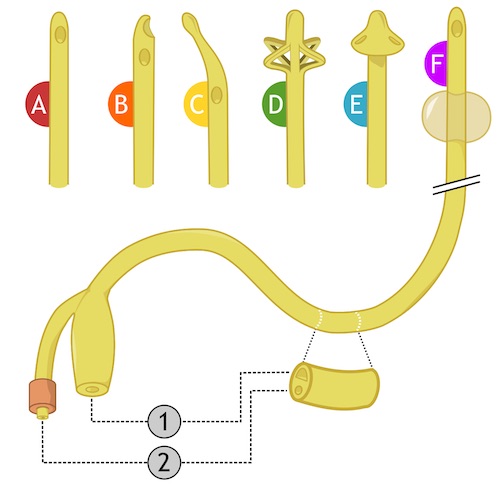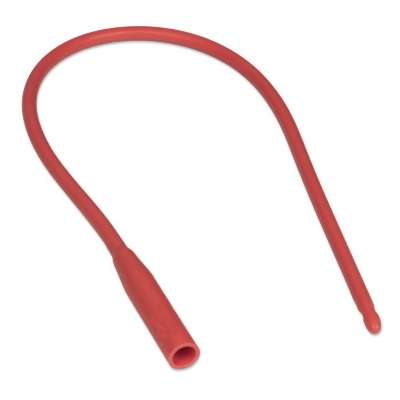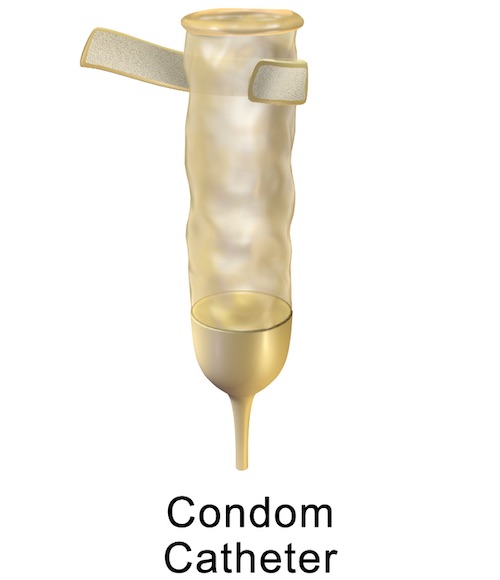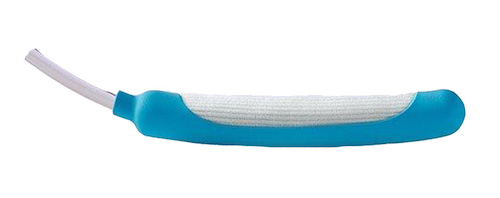Urology: Urinary Catheter
Urinary Catheter
Types of Catheters
- Urethral Catheter – Tube Placed through the Urethra to Drain the Bladder
- External Catheter – Suction Device Used to Externally Collect Urine without an Invasive Tube
- Suprapubic Catheter – Tube Placed Through the Abdominal Wall into the Bladder
Urethral Catheters
- Types:
- Indwelling (Foley) Catheter – Long-Term Flexible Catheter to Continually Drain Bladder with a Distal Balloon to Prevent Catheter from Falling Out
- Intermittent (Straight) Catheter – Flexible Catheter Removed After Each Use
- Red Rubber Catheter – Straight Catheter Made of Rubber, More Flexible than Traditional Plastic Catheters
- Specialized Foley Catheters:
- Coudé (Tiemann) Catheter – Curved Tip to Facilitate Passage through the Curved Prostatic Urethra
- Council Tip Catheter – Small Hole at the Distal End Allows Catheter to Pass Over a Wire
- Triple Lumen/Three-Way Catheter – Third Lumen Used to Infused Saline or Irrigation
- Material:
- Silicone
- Latex
- PVC
- Coatings:
- PTFE
- Hydrogel
- Silicone Elastomer
- Sizes:
- 14-16 French (F) are Most Common in Adults
- Other Common Sizes Range from 10-28 F
External Catheters
- Types:
- Condom Catheter – Wraps Over the Penis for Use on Males
- PureWick Catheter – Sits Between the Labia for Use in Females
- Used to Decrease the Risk of UTI Associated with Urethral Catheters
- Caution: Collects Voided Urine but Cannot Drain Bladder to Manage Urinary Retention
Suprapubic Catheter
- The Most Invasive Option
- Approaches: Percutaneous (Generally Preferred), Laparoscopic or Open
- Types:
- Wing-Tip (Malecot) Drain
- Mushroom Drain
- Balloon (Foley) Catheter
- Benefits Over Urethral Catheters:
- Prevents Urethral Trauma & Stricture
- Increased Comfort & Satisfaction
- Permits Voiding Trials without Catheter Removal
- Less Interference with Sexual Activity
- Cather Should Not Be Removed for 4-6 Weeks to Allow Tract to Mature, Accidental Early Removal May Require Surgical Repair
Indications for Urethral Catheter Placement
- Acute Urinary Retention or Bladder Outlet Obstruction
- Chronic Obstructions are Generally Better Managed by Intermittent Catheterization
- Need for Accurate Urinary Output Measurements in a Critically Ill Patient
- Perioperative Use:
- Undergoing Urologic Procedures
- Anticipated Prolonged Surgery
- Anticipated Large Volume Infusion or Diuresis
- Need for Intraoperative Monitoring of Urine Output
- Assist in Healing of Sacral/Perineal Wounds in Incontinent Patients
- Prolonged Immobilization
- Comfort in End of Life Cares if Needed
Complications
- Catheter-Associated Urinary Tract Infection (CAUTI) – The Most Common Healthcare-Associated Infection
- *See Urology: Urinary Tract Infection (UTI)
- Indwelling Bladder Catheter Risk: 3-10% Per Day of Catheterization
- Pain/Stinging Sensation
- Urethral Injury
- Paraphimosis
- Catheter Obstruction
CAUTI Prevention
- Avoid Unnecessary Catheters
- Use Sterile Technique in Placement
- Remove Catheter as Soon as Possible
- No Proven Benefit:
- Antibiotic-Coated Catheters
- Prophylactic Antibiotics
- Routine Catheter Exchange at Fixed Intervals

Urinary Catheters; (A) Simple, (B) Open-Ended/Whistle-Tip, (C) Coude/Tiemann, (D) Maslecot/Wing-Tip, (E) Muschroom, (F) Foley; (1) Urinary Drainage Lumen, (2) Balloon Inflation Lumen 1

Red Rubber Catheter

Condom Catheter 3

PureWick Catheter
References
- Komorniczak M. Wikimedia Commons. (License: CC BY-SA-3.0)
- Blaus B. Wikimedia Commons. (License: CC BY-SA-4.0)